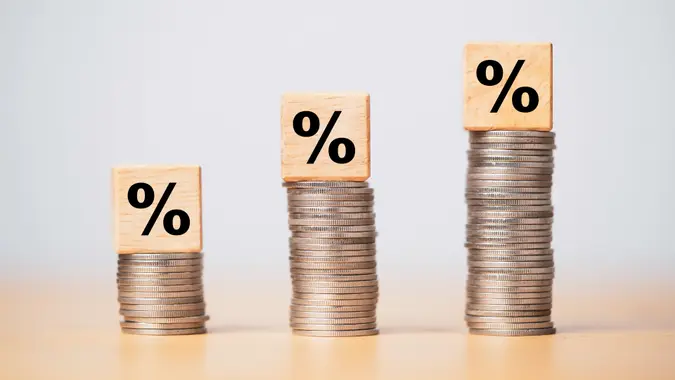How the Federal Reserve Impacts Savings Account Interest Rates

Commitment to Our Readers
GOBankingRates' editorial team is committed to bringing you unbiased reviews and information. We use data-driven methodologies to evaluate financial products and services - our reviews and ratings are not influenced by advertisers. You can read more about our editorial guidelines and our products and services review methodology.

20 Years
Helping You Live Richer

Reviewed
by Experts

Trusted by
Millions of Readers
The Federal Reserve serves a number of functions to help the U.S. economy operate efficiently. But when it comes to how the Fed impacts savings account interest rates, monetary policy plays the biggest role. This mandate of the Fed requires it to modify the money supply. They do this through changing interest rates, to help the economy achieve full employment, stable growth and benign inflation.
Although the Fed doesn’t directly control savings account interest rates, its monetary policy can have a very strong influence on the APY that these accounts pay. APY, or annual percentage rate, is that amount that you earn over the course of the year on an account if you reinvest your dividends all year. When the Fed raises rates, APYs on savings accounts go up, so it’s important to understand that relationship.
Here’s a deeper look at the interplay between APY and the actions of the Federal Reserve.
What Are Federal Reserve Rates?
The federal funds rate is the amount that banks charge one another for overnight loans. Banks borrow from one another on an overnight basis to help maintain their liquidity and reserve requirements, and it’s a fairly common thing. In other words, these loans help keep the American economy liquid and flowing.
But the effect the fed funds rate has on the overall economy extends far beyond what banks charge to one another for overnight loans. Ultimately, raising or lowering the federal funds rate affects the money supply in America. Monetary policy is one of the tools the Fed can use to manage inflation, employment and economic growth in the country. When rates go up, loans become more expensive, restricting economic growth. When businesses and individuals have to pay more to borrow money, less economic activity is generated.
Imagine, for example, that you’re looking to buy your first home. Money may be a little tight, but you’ve finally managed to scrape together enough money for a 20% down payment. With your budget stretched thin, you look at how much you will have to pay monthly to buy your home. If mortgage rates are 3%, you’re much more likely to be able to afford that house than if rates are at 7%, for example. That difference translates to hundreds of dollars per month in your monthly payment — or thousands of dollars per year — and could determine whether or not you get your home. This is just one example of how the federal funds rate ripples through the economy.
What Is APY, and Why Does It Matter?
Annual percentage rate, or APY, is similar to the interest rate you earn or pay on an account, but it’s slightly different. Whereas a stated interest rate is fixed, APY factors in the effect of compounding. For example, if you have $10,000 in a savings account that pays an interest rate of 4%, you’ll have more than $10,400 in the account at the end of the year if you reinvest your dividends. You’ll actually end up with $10,407. In this scenario, your APY is actually 4.07%, not just 4%.
In other words, APY shows you the full amount that you will earn if you continually reinvest your dividends and earn the benefits of compound interest. While a savings account isn’t the place you want to keep money for long-term investment goals, over time, even your emergency funds over other short-term savings accounts can benefit from compound interest, which boosts their long-term return.
Savers should keep an eye on APY trends because it can help dictate your savings and investment strategy. If rates are falling, a variable-rate account like a savings account may not be the best option, as your APY will fall. But if rates are rising, a savings account is a great place to store short-term money, as your APY will increase over time as well.
The Direct Link Between Federal Reserve Rates and APY
Although the Fed doesn’t dictate market interest rates, when it changes the fed funds rate, banks spring into action. As market rates rise, banks have to adjust their own offerings in order to compete. If the bank down the street bumps up the rate on their savings account by 0.25% in response to the Fed raising rates, banks that fail to match that adjustment risk losing deposits.
Imagine that you’ve got $10,000 in a savings account paying 4% interest. Over the course of a year, if you reinvest your dividends, you’ll end up with $10,407 in your account. But if the Fed cuts rates in four quarter-point increments down to 3%, you’ll only end up with $10,304 in your account, a reduction of $103.
How Quickly Do Federal Reserve Rate Changes Affect APY?
The first thing you’ll likely notice if you take the time to look is that banks adjust the rates on their loan products almost immediately after a Fed rate hike. This is because they’re essentially given free reign to boost the rates on everything from mortgages and auto loans to credit card rates. What tends to happen more slowly is that banks will raise the rates they have to pay on deposit accounts, such as savings accounts. They can’t drag their feet in raising the rates they pay, or they may lose assets to faster-moving competitors. However, the longer they can hold off paying more after they bump the rates on loan accounts from which they earn, the better their bottom line will look.
Online banks, which are already leaders in terms of APY payouts on savings accounts, are generally quickest to act, as for the most part they don’t have large loan portfolios. Some don’t even offer products like mortgage or home loans at all. So, the faster an online bank can boost its savings APY, the more likely it is to draw new deposits.
While no one can predict with absolute certainty what the Fed will do at any given time, it does try to be transparent with its actions so that there are no major market upsets. This information is widely distributed to analysts and the financial press, so if you keep an eye on the current pulse of the markets, you should have a bit of a heads-up as to which direction rates are generally heading.
The Impact of Rising Federal Reserve Rates on Savings Accounts
A rising federal funds rate can be problematic for borrowers, but it’s exactly what savers want to see. When the Fed raises interest rates, it’s all but certain that it will lead to increased APYs for savers. And as the Fed rarely makes just a single move, one interest rate hike is often the precursor to additional hikes. This is great for variable-rate accounts like high-yield savings accounts, which adjust their rates rapidly in response to hikes in the fed funds rate.
The Impact of Falling Federal Reserve Rates on APY
The downside of a variable-rate account like a savings account is that when the fed funds rate falls, so too do savings rates. If the Fed embarks on an extensive rate-cut cycle, the APY you earn on your savings account can fall precipitously. During the pandemic, for example, savings rates were cut to nearly zero, and for a significant amount of time. While this helped the economy recover rapidly, it torpedoed the earnings of savers.
To mitigate the impact of lower rates, it’s good to include some fixed-rate investments in your portfolio, in addition to variable-rate options like savings accounts or money market accounts. Bonds and CDs, for example, pay set interest rates, allowing you to lock in higher rates for an extended period of time.
How To Maximize Savings in Any Rate Environment
The best way to maximize savings in any rate environment is to own a variety of interest-bearing investments. As the long-term trend in interest rates is unknowable, having a combination of different types of investments can help protect you. For example, if you have both fixed-rate and variable-rate investments, such as CDs and savings accounts, you won’t get burned if rates move higher or lower. A portion of your account will pay a fixed rate, keeping your income high if rates fall, while a portion will be variable, meaning your income will rise when rates increase. This gives you the flexibility to survive any rate-change cycle.
Another strategy to take out the guessing from the interest-rate game is to build a CD ladder. This involves spreading out your investments equally among CDs with different maturities. For example, if you have $10,000 to invest, you can put $1,000 into CDs with maturities from 1-year to 10-years. As each CD comes due, you reinvest the money back at the long end of the ladder. This way you can lock in generally higher long-term rates and still have the flexibility of short-term cash coming due regularly.
The bottom line is that you shouldn’t base your long-term investment strategy on what interest rates will do over the short-term. If you take as much variability as you can out of your account regarding interest rate movements, you can concentrate on what will give you the best long-term return.
FAQ
- Why does the Federal Reserve change interest rates?
- The Federal Reserve changes interest rates to ensure a stable economy, to keep inflation in check and to maintain full employment. If inflation is too high, it can cripple the economy, so the Fed will raise rates to bring it down. Conversely, if the economy falls into a recession and jobs are at risk, the Fed will lower rates to help maintain full employment and boost growth.
- How often does the Fed adjust rates?
- The Fed can move relatively quickly, adjusting rates upwards or downwards several times per year, or it can do nothing for years at a time. It all depends on the economic cycle. During true crisis moments, like the housing collapse of 2008 or the coronavirus pandemic of 2020, the Fed can take direct, immediate action, cutting rates by a significant amount effectively overnight.
- What types of accounts are most affected by changes in APY?
- Any account that charges or pays an APY will be affected by changes. Savings rates will go up, which is a boon for savers, but new borrowers will suffer, as loans they take out, such as auto loans, home mortgages or credit cards, will cost more.
- Can I predict how APY will change after a Fed meeting?
- Banks generally adjust rates by the same amount that the federal funds rate changes. So, if the Fed raises rates by 0.25%, for example, you can expect to see your credit card rate go up by that much as well. Savings APYs often go up by the same amount, but banks are sometimes slower to pass the full amount of the rate increase through to customers. For example, your bank might only bump its savings account APY up by 0.20% if the Fed raises rates by 0.25%.
- How can I find the best APY during rate fluctuations?
- An online search is often the best way to find the top available savings rates during APY fluctuations. Many financial news sites regularly publish lists of the current best rates across a variety of product lines, including savings accounts.
 Written by
Written by  Edited by
Edited by 

























